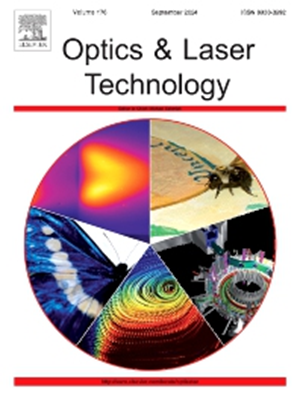利用优化的扩展型相位迭代引擎测量探针的倾斜相位
IF 4.6
2区 物理与天体物理
Q1 OPTICS
引用次数: 0
摘要
在分割镜和合成孔径望远镜中,共聚焦和共相位检测是实现理想分辨率的主要手段。扩展型相位迭代引擎(extended tychographic iterative engine, ePIE)作为一种无透镜相位检索方法,具有重建精度高、光路简单、操作简单等明显优势,在上述领域显示出巨大的应用潜力。然而,我们在这项工作中的研究结果表明,当前的ePIE算法无法测量照明探头包含倾斜相位时的相位。精确测量倾角相位是实现该算法相位测量的基础,具有重要的应用价值;否则,将导致所有相位测量的失败。提出了一种优化的ePIE算法,通过优化探针倾斜相位的初始估计值和限制重构探针的范围来测量探针倾斜相位。仿真和实验结果验证了该方法的有效性。举例说明:在单探头实验中,当引入实际倾角为0.4991°和0.9983°时,测量相位的相对误差(REs)分别为2.06%和2.40%;在双探头同步实验中,上述实测角的REs分别为1.84%和1.61%。通过仿真分析了初始估计和范围限制对测量结果的影响以及噪声的鲁棒性。它可以同时测量多个探头的倾斜相位,也可以测量相对活塞相位,为分割镜望远镜,特别是稀疏口径望远镜提供了一种潜在的共焦共相检测方法。本文章由计算机程序翻译,如有差异,请以英文原文为准。
Tip-tilt phase measurement of probe using an optimized extended ptychographic iterative engine
Co-focus and co-phase detections are the primary means to achieve the desired resolution in segmented mirror and synthetic aperture telescopes. As a lensless phase retrieval method, extended ptychographic iterative engine (ePIE) has obvious advantages such as high reconstruction accuracy, simple optical path and operation, and shows great application potential in the above field. However, our research results in this work show that current ePIE algorithm cannot measure the phase of illumination probe when it contains a tip-tilt phase. Accurately measuring tip-tilt phase is a foundation and is highly valuable for phase measurement by this algorithm; otherwise, it will result in the failures of all phase measurements. An optimized ePIE algorithm was presented to measure the tip-tilt phase of the probe by optimizing the initial estimate of the tip-tilt phase and limiting the range of reconstructed probe. Its validity was demonstrated by both simulated and experimental results. As examples: in single probe experiments, the relative errors (REs) of the measured phases are 2.06% and 2.40% for the introduced real tilted angles of 0.4991° and 0.9983°, respectively; in a simultaneous double probe experiment, the REs are 1.84% and 1.61% for the above real angles, respectively. The impacts of the initial estimate and the range limitation on measurement result, and noise robustness, were analyzed by simulations. It can measure the tip-tilt phases of multiple probes simultaneously, and also measure the relative piston phase, providing a potential co-focus and co-phase detection method for segmented mirror telescopes, especially for sparse aperture telescopes.
求助全文
通过发布文献求助,成功后即可免费获取论文全文。
去求助
来源期刊
CiteScore
8.50
自引率
10.00%
发文量
1060
审稿时长
3.4 months
期刊介绍:
Optics & Laser Technology aims to provide a vehicle for the publication of a broad range of high quality research and review papers in those fields of scientific and engineering research appertaining to the development and application of the technology of optics and lasers. Papers describing original work in these areas are submitted to rigorous refereeing prior to acceptance for publication.
The scope of Optics & Laser Technology encompasses, but is not restricted to, the following areas:
•development in all types of lasers
•developments in optoelectronic devices and photonics
•developments in new photonics and optical concepts
•developments in conventional optics, optical instruments and components
•techniques of optical metrology, including interferometry and optical fibre sensors
•LIDAR and other non-contact optical measurement techniques, including optical methods in heat and fluid flow
•applications of lasers to materials processing, optical NDT display (including holography) and optical communication
•research and development in the field of laser safety including studies of hazards resulting from the applications of lasers (laser safety, hazards of laser fume)
•developments in optical computing and optical information processing
•developments in new optical materials
•developments in new optical characterization methods and techniques
•developments in quantum optics
•developments in light assisted micro and nanofabrication methods and techniques
•developments in nanophotonics and biophotonics
•developments in imaging processing and systems

 求助内容:
求助内容: 应助结果提醒方式:
应助结果提醒方式:


